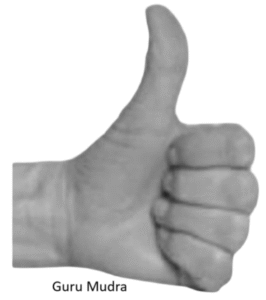Merudanda Mudra
Introduction
Merudanda Mudra is an ancient yogic hand gesture connected with pranic flow regulation along the spinal column (Meru Danda). In yogic texts, the spine is often considered the axis of the body and the seat of kundalini energy.
Meru = mountain / spine
Danda = staff / support
Mudra = seal / gesture
Thus, this mudra symbolizes the staff of life (spinal cord) and helps in channelizing energy upward through the sushumna nadi.
Meaning
The mudra represents the stability of the spine, which is essential for physical posture, energetic balance, and spiritual awakening. Practicing this mudra is said to harmonize the flow of prana in the three main nadis—ida, pingala, and sushumna—bringing balance between activity and rest, mind and body, left and right hemispheres.
How to Perform Practice
Sit in Sukhasana, Padmasana, or Vajrasana, with an erect spine.
Place both hands on the knees, palms facing upward.
Curl the fingers inward, placing the tips of the four fingers into the palm.
Extend the thumbs upward, pointing toward the sky.
The hands resemble thumbs-up fists resting on the knees.
Keep the spine upright and shoulders relaxed.
Breathe deeply and steadily while maintaining awareness on the spinal column.
Visualize prana moving up and down the spine with each breath.
Benefits
Physical Benefits:
Strengthens spinal alignment and posture.
Enhances lung capacity by opening the chest.
Improves energy flow through the nervous system.
Mental Benefits:
Enhances concentration and grounding.
Balances the sympathetic and parasympathetic nervous systems.
Reduces restlessness and anxiety.
Spiritual Benefits:
Activates the sushumna nadi for kundalini awakening.
Helps in meditation, balancing ida (moon energy) and pingala (sun energy).
Cultivates stability, courage, and resilience.
Contraindications
Those with severe spinal disorders (e.g., slipped disc, spinal injury) should avoid long practice.
High blood pressure patients should practice under guidance, as prana flow intensification may cause discomfort.
Not recommended during extreme fatigue, dizziness, or vertigo.
Anatomy & Physiology
Spinal Column: Supports structural integrity, posture, and nerve flow.
Respiratory System: Promotes deeper breathing due to upright posture.
Nervous System: Activates spinal nerve roots, improves communication between brain and body.
Circulatory System: Facilitates oxygenation of the brain by improving posture and breath.
Kinesiology
The thumbs pointing upward represent energy flow and upward extension of the spine.
Flexed fingers engage flexor muscles of the hand while thumbs activate the extensors, creating balance.
The mudra encourages isometric stability in arms and shoulders while focusing awareness on the axial skeleton (spine).
Neurology
Stimulates the autonomic nervous system through spinal awareness.
Balances right and left hemispheres via symbolic alignment of ida & pingala.
Enhances neuroplasticity through mindful breathing and posture control.
Promotes activation of parasympathetic tone, encouraging calm and meditative states.
Duration of Mudra
Beginners: 5–10 minutes daily.
Intermediate: 15–20 minutes in meditation or pranayama.
Advanced: Can be integrated into longer meditation sessions (30–45 minutes).
Best practiced during early morning or evening meditation.
Counter Mudra
Chin Mudra – for grounding and balancing energy after spinal activation.
Prana Mudra – for revitalization if fatigue occurs.
Shakti Mudra – for relaxation and calming after stimulating Merudanda.
Conclusion
Merudanda Mudra is a spinal energy-balancing gesture that stabilizes posture, harmonizes pranic currents, and supports meditation. It symbolizes the spine as the staff of life, holding the body upright and guiding energy upward. Through regular practice, one develops inner strength, balance, and spiritual awakening.
FAQ
Q1: What is the main purpose of Merudanda Mudra?
To balance energy along the spine and prepare the body for meditation and pranayama.
Q2: Can it help with back pain?
Yes, by promoting spinal awareness and posture, but avoid long practice if there is injury.
Q3: Is it linked to kundalini?
Yes, it awakens and balances energy in sushumna nadi, aiding kundalini activation.
Q4: How is it different from Prana Mudra?
Prana Mudra focuses on energizing life force, while Merudanda Mudra stabilizes and directs it along the spine.
Q5: Can beginners do it?
Yes, but should start with short durations and proper posture guidance.
References
Swami Satyananda Saraswati, Asana, Pranayama, Mudra, Bandha (Bihar School of Yoga).
Gertrud Hirschi, Mudras: Yoga in Your Hands.
Saraswati, Sivananda Tradition Yoga Texts on Mudra and Kundalini.
Yoga International & Bihar Yoga publications.
